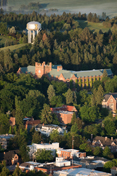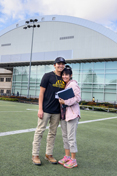College of Science Kudos December 2024
December 05, 2024
Grants Funding
New PI and co-PI grants awarded beginning summer 2024
Deb Stenkamp (professor, Biological Sciences): $2,630,628, NIH R01, Patterning Genes in Retinal Development.
Alistair Smith (professor and chair, Earth and Spatial Sciences)
- $337,873, NASA ROSES, Advancing Remote Sensing of Pre- Active, and Post-Fire Conditions Through the FireSense Implementation Team.
- $85,527, NIFA, Oaks Impact subaward.
Renee Love (assistant professor, Earth and Spatial Sciences): $54,942, NSF I-CREWS seed grant, Conflict or Benefit? Subsurface Uranium Deposit Interactions with a Potential Future Groundwater Source: A Case for Energy-Water Interactions.
Kris Waynant (associate professor, Chemistry and director, Office of Undergraduate Research)
- $408,331, NSF, Collaborative Research: CAS-SC: Investigating the Mild Ligand-Based Oxidative Dissolution of E-Waste Metals and Their Reductive Recovery.
- $65,000, SBOE, HERC OUR
- $598,537, NIH INBRE supplement, with Nate Schiele and Matt Bernards from the College of Engineering
Andreas Vasdekis (associate professor, Physics): $2,140,000, DOE, Entanglement-Enhanced Visual Metabolomics: from Single-Cells to Populations.
Zach Etienne (associate professor, Physics):
- NSF $404,286, Frameworks: E=mc2 - Enabling Multi-messenger Astrophys-ics through Community-driven Cyberinfrastructure.
- NSF $180,000, Democratizing Numerical Relativity: Advancing Binary Black Hole Simulations on Consumer-Grade Hardware.
Meng Zhao (assistant professor, Earth and Spatial Sciences):
- $750,000, NASA EPSCoR, SMD/GSFC: Improving Global Dryland Streamflow Modeling by Better Characterizing Vegetation Use of Deep-Water Resources Us-ing NASA's GRACE/GRACE-FO, SWOT, and LIS.
- $300,000, NCAR NSF EPSCoR, Enhancing Water Budget Simulations Across CONUS: Modeling Vegetation Uptake of Rock Moisture.
Esteban Hernandez-Vargas (assistant professor, Mathematics and Statistical Science) and Tanya Miura (professor and chair, Biological Sciences): $839,174, NIH COBRE supplement, Space and Time-dependent Response to Viral Infection In the Lung.
Barrie Robison (professor, Biological Sciences, and director, Institute for Interdisciplinary Data Science) and colleagues from the Office of Research and Economic Development: $4,546,903, NIH, Crossing the Innovation Valley of Death: Democratizing Data and Artificial Intelligence for Research Administration.
Felix Liao (associate professor, Earth and Spatial Sciences): $298,583, NIH COBRE supple-ment, Maternal Health in Idaho.
Jeff Hicke (professor, Earth and Spatial Sciences): $66,265, USDA Forest Service, USDA FS FHP-Spl-Pro-Prog: STDP tool.
Rob Ely (professor, Mathematics and Statistical Science): $341,104, NSF, Collaborative Research: Characterizing and Fostering Playful Mathematics in Grades 9-16.
Liz Cassel (associate professor, Earth and Spatial Sciences): $304,910, NSF, Collaborative Research: Deciphering Colorado Plateau Paleoelevation and Environmental Dynamics: Multi-Proxy Isotopic and Basin Analysis of the Miocene Bidahochi Formation.
Eric Mittelstaedt (associate professor, Earth and Spatial Sciences): $315,794, NSF, Merging Particle Physics and Earth Science to Develop a New Tool to Constrain the Physical and Chemical Properties of LLSVPs.
Matt Hedman (associate professor, Physics): $20,875, Jet Propulsion Laboratories, Quantifying the Detectability of Potential Plume Signals With MISE.
Christine Parent (associate professor, Biological Sciences), $277,923, NSF, MCA: A Slimy Study of Species Diversification and Community Assembly in Andean Land Snails.
Scott Grieshaber (professor, Biological Sciences) and Nicole Grieshaber (associate professor, Biological Sciences): $202,500, NIH, Understanding the Cell Forms That Underlie the Chlamydial Developmental Cycle.
Selected Publications
Esteban Hernandez-Vargas (assistant professor, Mathematics and Statistical Science) and U of I postdoctoral researcher Rodolfo Blanco-Rodrígues co-authored an article in Scientific Reports titled Assessing the impacts of vaccination and viral evolution in contact networks.
Scott Nuismer (professor, Biological Sciences) and Chris Remien (associate professor, Mathematics and Statistical Science) published an article in PLOS Computational Biology titled Quantifying the risk of spillover reduction programs for human health.
Stefan Tohaneanu (associate professor, Mathematics and Statistical Science), published a book titled Communicative Algebra Methods for Coding Theory as volume 97 of the series De Gruyter Studies in Mathematics.
Rob Ely (professor, Mathematics and Statistical Science) published a textbook titled The Learning and Teaching of Calculus: Ideas, Insights and Activities.
Paul Rowley (associate professor, Biological Sciences) published an article in Applied and Environmental Microbiology titled Inhibition of diastatic yeasts by Saccharomyces killer toxins to prevent hyperattenuation during brewing. This research has been featured in numerous media reports, and Professor Rowley was interviewed on NPR Cincinnati about his lab’s work to solve the problem of yeasts that spoil fresh beer and that can make beer bottles explode!
Grant Harley (associate dean and associate professor, Earth and Spatial Sciences) co-authored an article in Global Change Biology titled Asymmetric effects of hydroclimate extremes on eastern US tree growth: Implications on current demographic shifts and climate variability.
Erika Rader (associate professor, Earth and Spatial Sciences) published an article in Icarus titled Evidence of a Martian spatter cone south of Pavonis Mons.
Diana Mitchell (associate professor, Biological Sciences) published an article in Frontiers in Cell and Developmental Biology titled Forced MyD88 signaling in microglia impacts the production and survival of regenerated retinal neurons.
In Case You Missed It
Three College of Science students received Alumni Awards for Excellence as outstanding graduating seniors:
- Dayna Buitron, microbiology (Douglas Cole, Biological Sciences, mentor)
- Claire Qualls, biology (Ray von Wandruszka, Chemistry, mentor)
- Avneet Virk, statistics (Mimi Kestle, International Programs, mentor)
Scott Kinkead (Ph,D. chemistry '84) and Steven Smith (B.S. zoology '68) were inducted into the University of Idaho Alumni Hall of Fame in the spring.
Gary L. Bennett (B.S. and M.Nuc.Sc. physics ‘62, ‘66) won the 2024 Robert L. Forward Award from the American Institute of Aeronautics and Astronautics in honor of his lifetime of service in the pursuit of advanced propulsion science and technology.
Gary L. Bennett also contributed a chapter (Electrical Power Options for Interstellar Spacecraft) for a new book, Interstellar Travel: Propulsion, Life Support, Communications, and the Long Journey. Editors: Les Johnson, Kenneth Roy (2024).
David Hawk (B.S. geology ’67) was elected chair-elect of the House of Delegates of the American Association of Petroleum Geologists (AAPG).
Jim Nagler (professor, Biological Sciences), in collaboration with scientists from the Columbia River Inter-Tribal Fish Commission, is working to reverse declines in populations of the Pacific lamprey, an important Indigenous food source. Nagler’s U of I collaborator, Lea Medeiros (Biological Sciences) was interviewed by KTVB-TV.
Scott Grieshaber (professor, Biological Sciences) and his colleague Daniel Rockey discussed their work understanding Chlamydia pathogenesis, Chlamydia’s unique persistence strategy, and the impact of their research with Meena Ramchandani, editor of the National STD Curriculum Podcast.
Morgan Salisbury (B.S. geology ‘00), Instructor of Earth Sciences at Lower Columbia College, has received a Fulbright U.S. Scholar Program award in Earth Science Education to Bolivia for the 2024-2025 academic year from the U.S. Department of State and the Fulbright Foreign Scholarship Board.
Jennifer Pollard (Ph.D. chemistry ‘04), who is a chemistry teacher and department chair at Moscow High School, received the Glenn and Jane Crosby Northwest Region Award for Excellence in High School Teaching at the American Chemical Society Northwest Regional Meeting in June.
Kristen Martinet (Ph.D. bioinformatics and computational biology ’24) was featured in a BCB Spotlight. Kristen received the Paul Joyce Fellowship for 2023-2024 and accepted a postdoctoral position at the University of Arizona.
Trevor Crosby (B.S. geology ‘08, M.S. environmental science ‘18) was promoted to Director of Operations at UMIAQ Environmental.
The Princeton Review named U of I as a Best Value College. The university ranked #12 for Best Public Schools for Making an Impact based on student survey responses to questions covering community service opportunities, student government, sustainability efforts, and on-campus student engagement. Go Vandals!
Money ranked U of I one of the Best Colleges 2024.
Ellie Grant (B.S. medical sciences ’24) started a Master of Science in Physician Assistant Studies and Doctor of Health Science (MSPAS/DHSc) at Thomas Jefferson University.
Jon Gaffney (B.S. mathematics and history ’08) is serving as the current president of the U of I Alumni Association.
Paul Rowley (associate professor, Biological Sciences) was a featured speaker at the U of I Power of Possibility (POP) talks in October.
Current master’s degree biology student Megan Dobson (B.S. microbiology ‘22) won second place for her talk at the Entomological Society of America annual conference in Phoenix in November. She is mentored by Shirley Luckhart (professor, Biological Sciences)
Lily Givens, who is majoring in microbiology, won a poster award at the Northwest American Society for Microbiology branch meeting in Seattle in November. She is mentored by Paul Rowley (associate professor, Biological Sciences).
Peik Lund-Andersen (B.S. molecular biology and biotechnology, minor in mathematics ‘22) is currently a doctoral student in the lab of David Baker at University of Washington who was awarded 2024 Nobel Prize in Chemistry. Peik worked with Paul Rowley, Jagdish Patel, and Marty Ytreberg while at U of I.
About the University of Idaho
The University of Idaho, home of the Vandals, is Idaho’s land-grant, national research university. From its residential campus in Moscow, U of I serves the state of Idaho through educational centers in Boise, Coeur d’Alene and Idaho Falls, nine research and Extension centers, plus Extension offices in 42 counties. Home to more than 12,000 students statewide, U of I is a leader in student-centered learning and excels at interdisciplinary research, service to businesses and communities, and in advancing diversity, citizenship and global outreach. U of I competes in the Big Sky and Western Athletic conferences. Learn more at uidaho.edu.






